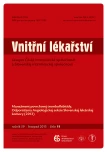The value of ECG assessment in pulmonary embolism diagnostics
Authors:
S. Daruľová; M. Stančík; P. Galajda; M. Belicová; M. Mokáň
Authors‘ workplace:
I. interná klinika Jesseniovej lekárskej fakulty UK a UN Martin, Slovenská republika, prednosta prof. MU Dr. Marián Mokáň, DrSc., FRCP Edin.
Published in:
Vnitř Lék 2013; 59(11): 1017-1021
Category:
Case Report
Overview
Acute pulmonary embolism is one of the most frequent and risky cardiovascular diseases. Despite accessability of different examinig methods and rich clinical experience, pulmonary embolism is demanding disease especially in diagnostics. The reason might be in clinical picture, that is not typical everytime and leads to incorrect choice of diagnostic methods, that delay the disease assesment. Regarding this, precise evaluation of every each symptom and basal, resp. supplemental examinations is important step to rapid and right assesment of this diagnose.
Key words:
acute pulmonary embolism – ECG
Sources
1. Vojáček J, Kettner J. Klinická kardiologie. Praha: Nucleus HK 2012.
2. Cohen TA, Agnelli G, Anderson AF et al. Venous thormbembolism (VTE) in Europe. The number of VTE events and associated morbidity and mortality. Thromb Haemost 2007; 98: 756– 764.
3. Stein DP. Pulmonary embolism. Massachusetts: Blackwell Publishing 2007.
4. Torbicki A, Perrier A, Konstantinides S et al. Guidelines on the diagnosis and management of acute pulmonary embolism: the Task Force for the Diagnosis and Management of Acute Pulmonary Embolism of the European Society of Cardiology (ESC). Eur Heart J 2008; 29: 2276– 2315.
5. Kosuge M, Kimura K, Ishikawa T et al. Electrocardiographic differentiation between acute pulmonary embolism and acute coronary syndromes on the basis of negative T waves. Am J Cardiol 2007; 99: 817– 821.
6. Goslar T. Podbregar M. Acute ECG ST – segment elevation mimicking myocardial infarction in a patient with pulmonary embolism. Cardiovasc Ultrasound 2010; 8: 50.
7. Widimský J. Diagnostika a léčba akutní plicní embolie v roce 2010. Vnitř Lék 2011; 57: 5– 21.
8. Widimský J, Malý J, Eliáš P et al. Doporučení diagnostiky, léčby a prevence plicní embolie – verze 2007. Doporučení České kardiologické společnosti. Vnitř Lék 2008; 54: 25– 72.
9. McGinn S, White PD et al. Acute cor pulmonale resulting from pulmonary embolism. JAMA 1935; 104:1473– 1480.
10. Stein DP, Dalen JE, McIntyre KM et al. The electrocardiogram in acute pulmonary embolism. Prog Cardiovasc Dis 1975; 17: 247– 257.
11. Sinha N, Yalamanchili K, Sukhija R et al. Role of the 12- lead electrocardiogram in diagnosing pulmonary embolism. Cardiol Rev 2005; 13: 46– 49.
12. Daniel RK, Courtney DM, Kline AJ. Assessment of cardiac stress from massive pulmonary embolism with 12- lead ECG. Chest 2001; 120: 474– 481.
13. Todd K, Simpson SC, Redfearn PD et al. ECG for the diagnosis of pulmonary embolism when conventional imaging cannot be utilized: A case report and review of the literature. Indian Pacing Electrophysiol J 2009; 9: 268– 275.
14. Brown G, Hogg K. Diagnostic utility of electrocardiogram for diagnosing pulmonary embolism. Emerg Med J 2005; 22: 729– 730.
Labels
Diabetology Endocrinology Internal medicineArticle was published in
Internal Medicine

2013 Issue 11
Most read in this issue
- Thyrostatic treatment and its adverse effects
- Inflammatory response and C‑ reactive protein value in patient with acute coronary syndrome
- The value of ECG assessment in pulmonary embolism diagnostics
- Management of superficialis thrombophlebitis. Guidelines of the Angiologiy Section of the Slovak Medical Chamber (2013)
